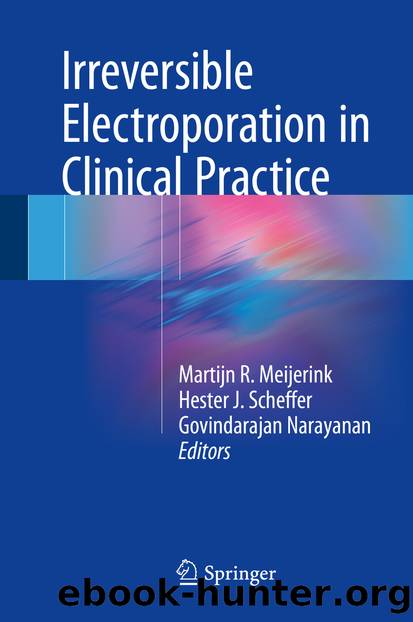Irreversible Electroporation in Clinical Practice by Martijn R. Meijerink Hester J. Scheffer & Govindarajan Narayanan

Author:Martijn R. Meijerink, Hester J. Scheffer & Govindarajan Narayanan
Language: eng
Format: epub
Publisher: Springer International Publishing, Cham
10.3.2 Malignant
Most malignant hepatic tumors in the Western world are metastases from different primary tumors, most often from colorectal origin. In Mediterranean, African, and Asian countries, hepatocellular carcinoma is more frequent.
10.3.2.1 Liver Metastases
A large number of primary malignancies have the ability to metastasize to the liver. There is general consensus that treatment of metastases from colorectal origin can be curative, and therefore local treatment should be initiated when tumor burden allows for complete eradication. Although small bowel tumor metastases are rare, general consensus considers workup and treatment similar to metastases from colorectal origin. There is no consensus for treatment of metastases other than from intestinal origin. When oligometastases from different primary tumors are present (e.g., breast, lung, or melanoma), the indication for treatment should always be discussed in a multidisciplinary team.
Colorectal carcinoma is currently the third most common cause of cancer-related death in the Western world. The main area of concern for these patients is the development of hematogenous metastases in 40–60% of these patients, 50% of which have metastases present at time of diagnosis of the primary tumor [20]. Liver metastases are an important determinant of their prognosis; 5-year survival of patients without distant metastases at time of diagnosis is 60–95%; this drops dramatically to 8% when synchronous liver metastases are present [20].
Historically, surgical resection was considered the gold standard for potentially curative treatment. When all metastases can be resected, cure is possible resulting in a 5-year overall survival rate between 25% and 60% [21–23]. Nowadays, the only criteria for surgical resection are that the future remnant liver should exceed 25% in a healthy liver, and 30% after systemic chemotherapy or underlying liver disease, with adequate vascular in- and outflow and biliary drainage and at least two contiguous liver segments [24]. Despite broadening of the criteria for resectability, a large proportion (70–80%) of patients with CRLM are deemed unresectable owing to a insufficient future remnant liver volume, even after conversion chemotherapy. New surgical techniques have been developed to overcome this problem. Preoperative portal vein embolization (PVE) induces atrophy of the embolized, tumor-bearing liver segments, while compensatory hypertrophy occurs in the non-embolized lobe. This increases the future remnant liver volume and, supposedly, its function, enabling surgical resection of the tumors. Although this technique converts unresectable to resectable disease in selected patients, tumor progression has been described in the interval between embolization and resection, causing 6.4–33% of the metastases to be unresectable at time of surgery [25]. PVE is often used in a two-stage hepatectomy. In a two-stage strategy, compensatory liver regeneration after a first noncurative hepatectomy may enable a second curative resection. Seventy percent of the patients that were initially deemed eligible for this strategy have shown to undergo both operations.
The search for alternatives to achieve complete tumor eradication without the need for surgical resection already started in the 1980s and is still continuing. Local tumor ablation has emerged as a popular alternative to broaden the therapeutic possibilities for a selection of these patients, with radiofrequency ablation (RFA) as the clinically most relevant ablation technique up to date.
Download
This site does not store any files on its server. We only index and link to content provided by other sites. Please contact the content providers to delete copyright contents if any and email us, we'll remove relevant links or contents immediately.
| Anesthesiology | Colon & Rectal |
| General Surgery | Laparoscopic & Robotic |
| Neurosurgery | Ophthalmology |
| Oral & Maxillofacial | Orthopedics |
| Otolaryngology | Plastic |
| Thoracic & Vascular | Transplants |
| Trauma |
When Breath Becomes Air by Paul Kalanithi(7268)
Why We Sleep: Unlocking the Power of Sleep and Dreams by Matthew Walker(5649)
Paper Towns by Green John(4173)
The Immortal Life of Henrietta Lacks by Rebecca Skloot(3829)
The Sports Rules Book by Human Kinetics(3592)
Dynamic Alignment Through Imagery by Eric Franklin(3493)
ACSM's Complete Guide to Fitness & Health by ACSM(3470)
Kaplan MCAT Organic Chemistry Review: Created for MCAT 2015 (Kaplan Test Prep) by Kaplan(3428)
Introduction to Kinesiology by Shirl J. Hoffman(3305)
Livewired by David Eagleman(3128)
The River of Consciousness by Oliver Sacks(2995)
Alchemy and Alchemists by C. J. S. Thompson(2915)
The Death of the Heart by Elizabeth Bowen(2908)
Descartes' Error by Antonio Damasio(2740)
Bad Pharma by Ben Goldacre(2731)
The Gene: An Intimate History by Siddhartha Mukherjee(2495)
Kaplan MCAT Behavioral Sciences Review: Created for MCAT 2015 (Kaplan Test Prep) by Kaplan(2493)
The Fate of Rome: Climate, Disease, and the End of an Empire (The Princeton History of the Ancient World) by Kyle Harper(2441)
The Emperor of All Maladies: A Biography of Cancer by Siddhartha Mukherjee(2433)
